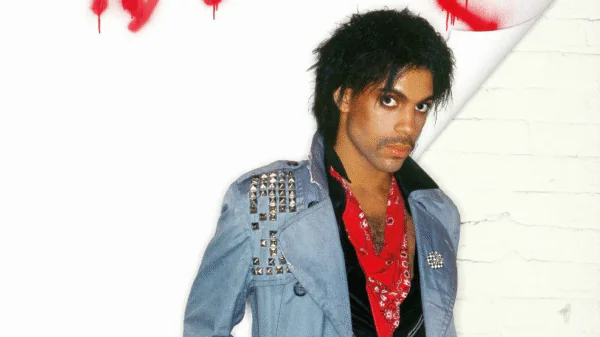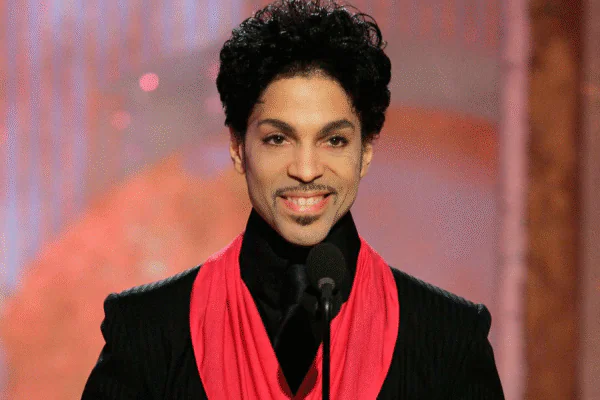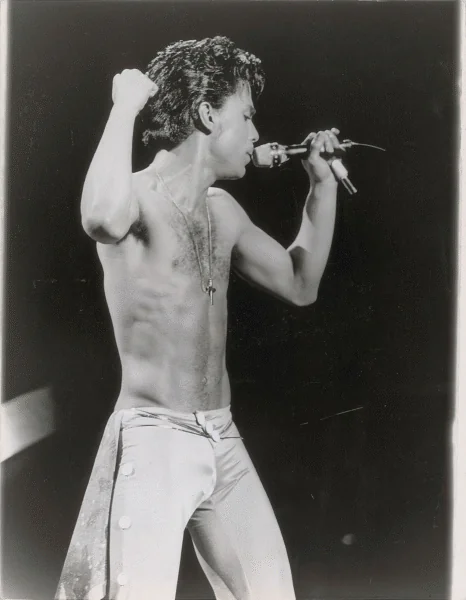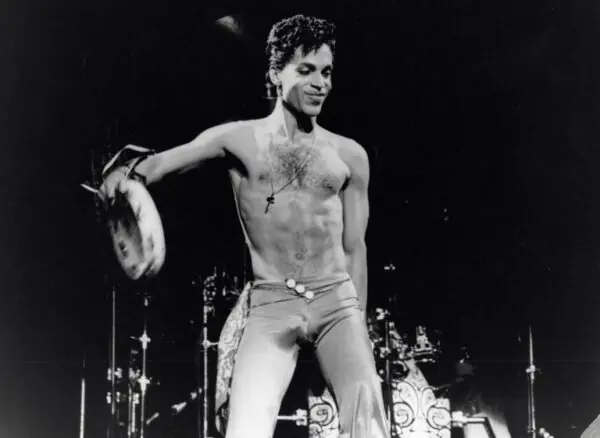Prince: Based on NeemTime research
Who is Prince (Biography/Personal Details)
Prince Rogers Nelson, known simply as Prince, was an iconic American singer, songwriter, musician, and record producer.
Born on June 7, 1958, in Minneapolis, Minnesota, Prince became a pioneer of funk, rock, pop, and R&B genres.
He was famous for his flamboyant stage presence, wide vocal range, and mastery of multiple instruments.
Prince released his debut album For You in 1978 at just 19 years old, which he produced almost entirely by himself.
Over his career, he sold over 150 million records worldwide, earning numerous awards including seven Grammys and an Academy Award.
Prince was known for his fierce independence in the music industry, famously battling record labels over creative control.
He changed his name to an unpronounceable symbol in the 1990s as part of a contract dispute with Warner Bros.
Prince was inducted into the Rock and Roll Hall of Fame in 2004, cementing his legacy as one of the greatest musicians of all time.
He passed away unexpectedly on April 21, 2016, at the age of 57, leaving behind an extensive vault of unreleased music.
Prince’s influence is still deeply felt in music today, inspiring countless artists across various genres globally.
Early Life Highlights of Prince (Background/Childhood)
Prince was born into a musical family; his father was a jazz pianist and songwriter, which influenced his early exposure to music.
Growing up in Minneapolis, he showed musical talent from an early age, learning piano, guitar, and drums by his teenage years.
Prince attended Minneapolis’ Central High School, where he formed his first band called Grand Central.
His childhood was marked by a mix of discipline and creativity, encouraged by his parents to pursue music seriously.
By age 12, he was already composing songs and performing in local bands around Minneapolis.
Prince’s early influences included Jimi Hendrix, James Brown, and Sly Stone, shaping his eclectic sound.
Despite his shy personality offstage, Prince’s ambition to become a music star was clear from a young age.
He caught the attention of Warner Bros. Records in his late teens, leading to his first recording contract.
Prince was also an avid reader and often incorporated philosophical and spiritual themes into his early songwriting.
His early experiences in Minneapolis’ vibrant music scene helped hone his signature blend of funk, rock, and soul.
Current Life Highlights of Prince (Career/Other Work)
Though Prince passed away in 2016, his estate continues to manage and release his vast archive of unreleased recordings.
Posthumous albums like Welcome 2 America and Piano & A Microphone 1983 have been critically acclaimed.
The Paisley Park estate in Minnesota has been transformed into a museum and tribute site attracting fans worldwide.
Prince’s music remains a staple in film, commercials, and pop culture, often sampled and covered by modern artists.
His legacy influences contemporary music styles, from R&B to alternative rock and electronic music.
Various documentaries and biopics have been produced since his death, offering insight into his complex personality and artistry.
Annual tributes and events celebrate his contributions, including special concerts on his birthday and death anniversary.
Collaborations and unreleased tracks featuring Prince’s vocals continue to emerge, sparking excitement among fans.
Prince’s philanthropy and activism, especially in supporting young musicians, are highlighted by foundations established in his name.
His influence is credited with breaking down racial and genre barriers within the music industry over decades.
Personal Life Highlights of Prince (Dating History/Family Members)
Prince married twice in his lifetime, first to dancer and singer Mayte Garcia and later to backing vocalist Manuela Testolini.
His marriage to Mayte Garcia was highly publicized but ended in divorce after the tragic loss of their infant son.
Known for his private nature, Prince rarely discussed his personal relationships in public interviews.
He was known to have numerous close friendships and romantic relationships with both men and women over the years.
Prince was deeply connected to his family, including his sister Tyka Nelson, who is also a singer.
His father, John L. Nelson, passed away in 2001, and Prince paid tribute to him in several songs.
Despite his fame, Prince maintained a low profile regarding his romantic life, focusing more on his art.
He had no publicly acknowledged children at the time of his passing.
Prince’s spirituality played a significant role in his personal life, with a private devotion to Jehovah’s Witnesses in later years.
Close friends describe him as loyal and intensely private, often guarded but deeply caring in personal relationships.
Prince Shirtless

Prince Shirtless 5

Prince Shirtless 4

Prince Shirtless 3

Prince Shirtless 2

Prince Shirtless
Prince Height / How to Get Body Like Prince
Prince stood approximately 5 feet 2 inches (157 cm) tall, which contributed to his unique stage presence.
Despite his shorter stature, he maintained a lean and agile physique through regular physical activity and dance.
Prince’s fitness routine often included dance rehearsals that doubled as intense cardio workouts.
He combined flexibility exercises with strength training to maintain his energetic performances.
His diet reportedly focused on balanced nutrition, favoring fresh vegetables, lean proteins, and hydration to sustain stamina.
Prince avoided extreme bodybuilding and instead emphasized a toned, natural muscularity suited to his style.
His fashion choices, including tailored suits and fitted outfits, accentuated his slim and athletic frame.
Prince incorporated yoga and stretching into his regimen to enhance mobility and prevent injuries on stage.
He believed that mental health and spiritual well-being were integral to maintaining physical fitness.
For those aspiring to get a body like Prince, a combination of consistent dance cardio, strength training with bodyweight exercises, and mindful eating is essential.
Interview Quotes of Prince (where/when)
In a 1984 interview with Rolling Stone, Prince said, “I want to be the closest thing to God.”
During a 1997 MTV interview, he stated, “Control your own destiny or someone else will.”
At the 2004 Rock and Roll Hall of Fame induction, Prince remarked, “Music is the only thing that makes sense anymore.”
In a 2010 interview with GQ, he shared, “I don’t do drugs. I am drugs.”
Prince told Spin magazine in 1985, “The beauty of music is that it transcends language.”
During a rare 2014 BBC Radio interview, he noted, “If you’re going to sing like someone else, then don’t sing at all.”
At the 2015 BET Awards, he urged, “Create your own path and don’t fear failure.”
In a 1991 Time interview, Prince said, “I’m not a womanizer, but I’ve had many, many women.”
During a 2000 VH1 special, he stated, “Art is about pushing boundaries and breaking molds.”
In one of his last interviews with Variety in 2016, Prince reflected, “My music is my diary, and every song is a chapter of my life.”
TV / Movie Quotes of Prince (where/when)
In the 1984 film Purple Rain, Prince’s character famously says, “Dearly beloved, we are gathered here today to get through this thing called life.”
During his 1990 cameo in Graffiti Bridge, Prince declared, “The most powerful thing in the world is the truth.”
In Under the Cherry Moon (1986), he delivers the line, “I’m the king of everything I see.”
From Purple Rain, the line “You want to see a star? Then you better take a chance on me” became iconic.
In Purple Rain, Prince’s music combined with his dialogue to express his philosophy on love and pain.
His voiceover in the 2010 documentary Sign o’ the Times reflects, “Music is where the heart and soul live.”
Prince’s TV interview on Saturday Night Live in 1985 included the memorable line, “If you don’t take risks, you can’t grow.”
In an episode of New Girl (2014), the characters quote his lyric, “Tonight we’re gonna party like it’s 1999.”
In Purple Rain, the line “Sometimes it snows in April” is used as a poignant metaphor for unexpected loss.
His brief role in Batman (1989) as a nightclub singer featured the line, “I’m not just music, I’m a mood.”
Controversies/Scandals of Prince
Prince’s public battle with Warner Bros. over his recording contract in the 1990s sparked widespread media attention.
He changed his name to an unpronounceable symbol partly as a protest against his label controlling his music rights.
Some critics accused Prince of controlling and isolating behavior in his personal relationships, though much remains private.
His sudden withdrawal from the public eye in the early 2000s fueled rumors about his health and career.
Prince faced backlash over provocative stage outfits and performances that challenged social norms.
There were controversies around his refusal to allow his music on streaming platforms for years, citing artistic control.
Allegations of strict control over collaborators and disputes with former band members surfaced sporadically.
Prince’s religious conversion to Jehovah’s Witnesses led to him censoring some earlier, more sexually explicit works.
Some family disputes arose posthumously regarding the control and release of his extensive music vault.
Despite occasional controversies, Prince maintained a reputation as a fiercely private and enigmatic artist who guarded his creative vision above all else.
Lesser Known Unknown Facts Trivia of Prince
Prince was a multi-instrumentalist who reportedly mastered over 27 instruments by the age of 20.
Despite his massive fame, Prince was known for recording entire albums in secret studios within his own home.
He was an avid chess player and believed the game sharpened his strategic thinking in music production.
Prince held a patent for a custom guitar design that integrated unique sound modulation features.
His vault of unreleased music is estimated to contain over 1,000 songs, many of which remain unheard by the public.
Prince was deeply involved in the visual arts and often sketched costume designs for his tours himself.
He was one of the first artists to demand ownership of his master recordings, setting a precedent in the music industry.
Prince occasionally released music under pseudonyms to experiment with new genres without fan expectations.
He composed a full jazz album that he never officially released but shared privately with close friends.
Prince’s love for purple extended beyond music and fashion—he even dyed his pet cat purple once as a playful statement.
Most Commonly Frequently Asked Discussed Questions/Topics with Answers on Prince
Q: Why did Prince change his name to a symbol?
A: Prince changed his name in 1993 to the “Love Symbol” as a protest against his record label’s control over his music rights.
Q: What was Prince’s real name?
A: His full birth name was Prince Rogers Nelson.
Q: How many instruments could Prince play?
A: He was proficient in over 27 instruments, including guitar, piano, drums, and bass.
Q: Did Prince write songs for other artists?
A: Yes, Prince wrote many hit songs for other artists such as “Nothing Compares 2 U” for Sinéad O’Connor and “Manic Monday” for The Bangles.
Q: What is the “Purple Rain” album’s significance?
A: “Purple Rain” is considered Prince’s magnum opus, blending rock, funk, and pop while winning multiple awards and defining his career.
Q: Why was Prince so private about his personal life?
A: Prince valued privacy to maintain control over his artistic image and avoid media intrusion.
Q: Did Prince have any controversies related to religion?
A: Yes, Prince converted to Jehovah’s Witnesses in the early 2000s, which led to him removing some of his earlier explicit content from public performances.
Q: How did Prince influence modern pop music?
A: Prince’s fusion of genres, innovative production techniques, and boundary-pushing performances have inspired countless artists across pop, R&B, and rock.
Q: What was Prince’s stance on streaming platforms?
A: Prince was initially opposed to music streaming, removing much of his catalog from services to protect artistic ownership and revenue.
Q: How did Prince die?
A: Prince died in 2016 from an accidental fentanyl overdose, which shocked fans worldwide and highlighted the opioid crisis.